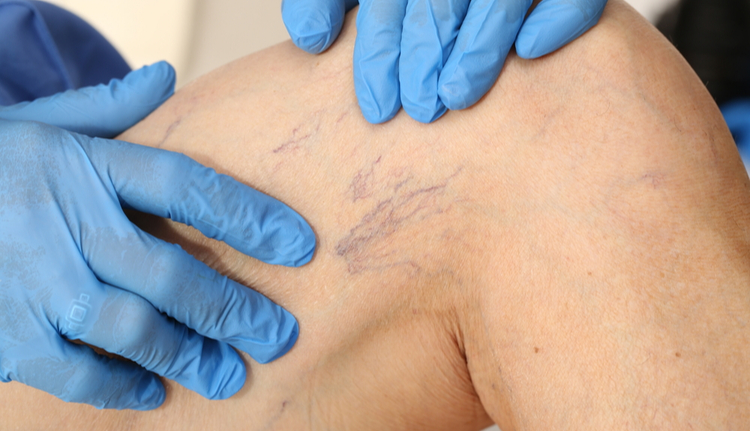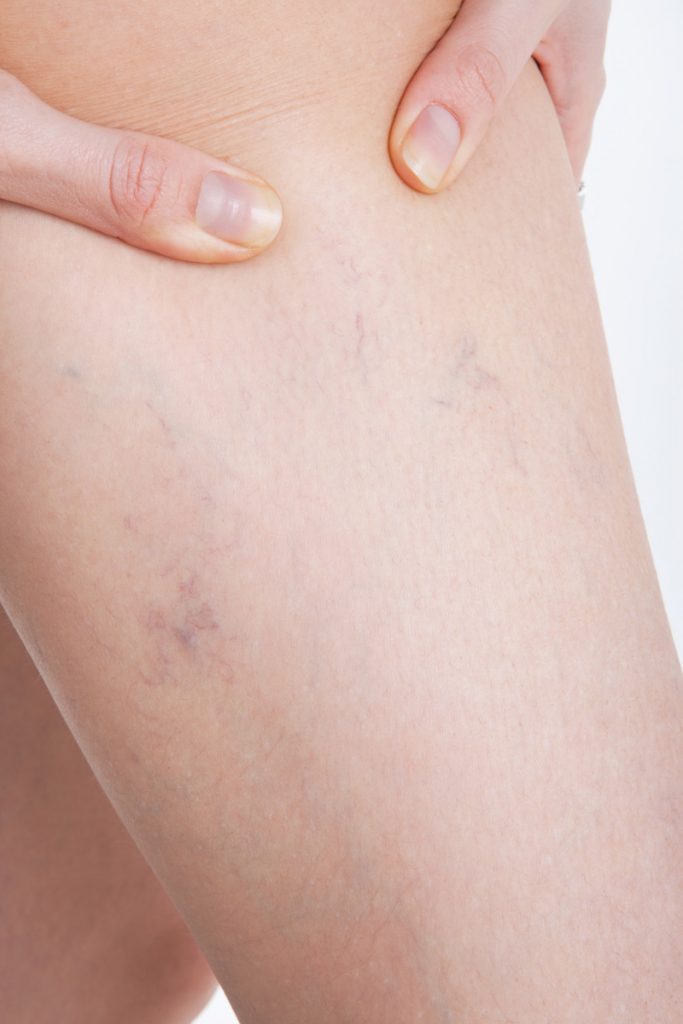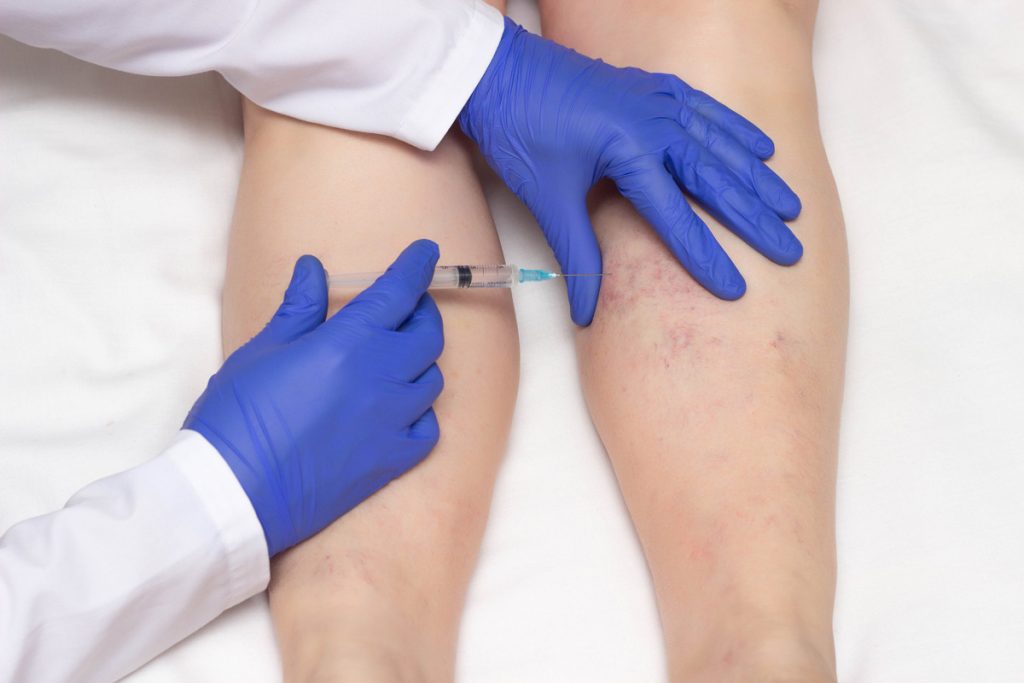Spider veins are tiny but visible veins that often appear on the legs and face. They mimic the intricate patterns of spider webs or tree branches. Similar to their larger counterpart, varicose veins, spider veins are more than just a cosmetic concern. They can signal deeper vein issues, such as varicose or spider veins, and even lead to discomfort and pain. Thankfully, advancements in vein treatment, including laser therapy and other varicose vein treatments, offer new hope.
Spider veins, those small, twisted blood vessels that are visible through the skin, resemble spider webs or tree branches and are usually found on the legs and face. They can be blue, red, or purple and while typically harmless, they can sometimes cause discomfort or indicate underlying health issues.
In addition to physical symptoms, spider veins can also cause emotional distress due to their appearance. Fortunately, advances in medical treatments and techniques offer new hope for those seeking to minimize or eliminate spider veins. This blog explores the latest options available for treating this common condition.
 What Causes Spider Veins?
What Causes Spider Veins?
Before delving into treatment options, it’s important to understand what causes spider veins. They result when valves in the veins that help regulate blood flow weaken. Blood pools in the veins instead of flowing smoothly back to the heart, causing veins to enlarge. Factors contributing to the development of spider veins include genetics, age, hormonal changes, obesity, lack of movement, and prolonged standing or sitting.
Spider veins are thread-like colored veins most often seen on the surface of the skin. They are usually not as painful as enlarged varicose veins, but they are still liable to bleed and worsen without treatment. Varicose veins occur most commonly in the legs but are also often seen in the face and elsewhere.
These varicose veins, medically referred to as telangiectasias, will not worsen to the point where they will ever become the large bulging varicose veins.
Spider veins usually emerge due to factors such as:
- Aging
- Hormonal fluctuations, especially during pregnancy
- High blood pressure
- Extended periods of standing or sitting
- Certain genetic factors
Compared to varicose veins, their larger and often painful counterparts, spider veins usually cause no symptoms and are often addressed for cosmetic purposes. Varicose veins are large, bulging veins that often present with pain or other symptoms like itching or leg swelling. They indicate more severe venous insufficiency and, if left untreated, can lead to complications such as deep vein thrombosis.
Spider and varicose veins are prevalent in the legs due to pressure from our body weight and the force of gravity. Working in tandem, they can weaken the one-way valves inside the veins, which are essential for aiding blood return to the heart.
So, how to treat these unwelcome, unsightly veins in your legs? Thanks to advancements in vein treatment options, we now have effective ways to treat both spider and varicose veins. Laser treatment, a popular option, targets and destroys these veins, allowing the body to absorb them over time naturally.
Remember, it’s not just about appearances. Treating spider veins can also help alleviate uncomfortable symptoms associated with larger veins. If you’ve noticed any changes in your leg veins or are experiencing discomfort, seeking treatment for varicose or spider veins can be a step towards healthier, happier legs. Knowledge is power when it comes to managing your vein health.
Traditional Treatments for Spider Veins
Traditional treatments have stood the test of time when it comes to managing spider veins. They offer relief not just from the appearance of these tiny, web-like veins but also from the discomfort they may sometimes cause. Two of the most reliable methods are sclerotherapy and laser treatments.
Sclerotherapy: The Gold Standard
One of the most popular and effective treatments for spider veins is sclerotherapy. This procedure involves injecting a solution directly into the vein, causing it to scar and forcing blood to reroute through healthier veins.
The collapsed vein is reabsorbed into local tissue and eventually fades. Recent advancements have improved the sclerosing agents used, making this procedure quicker and more comfortable with fewer side effects.
The process involves:
- Injecting a Solution: A special sclerosing solution is injected directly into the vein, causing it to collapse and fade over time.
- Efficacy: It is highly effective for treating spider veins and smaller varicose veins, with many patients seeing significant improvement.
- Multiple Sessions Required: Depending on the extent of the spider veins, multiple sessions might be needed to achieve the desired results.
- Possible Discomfort: While generally well-tolerated, some patients may experience mild pain or discomfort during the procedure.
Laser Treatments: High-Tech Help
Laser treatments are another excellent option for spider vein removal. Modern laser technology uses a precisely focused beam of light to heat and destroy the vein without damaging surrounding tissues.
The latest lasers are highly effective and often require fewer sessions than before, with minimal discomfort and recovery time. Laser treatments offer a non-invasive alternative to sclerotherapy and work by:
- Targeting Veins with Light: Strong bursts of light are directed onto the vein, making it slowly fade and disappear.
- Mechanism of Action: The laser’s heat damages the vein, causing scar tissue to form, which closes the vein. The closed vein loses its source of blood and dies.
- Variable Results: Not all skin and vein types achieve the same results with laser therapy; thus, it may take several treatments to notice improvements.
- Treatment Frequency: Patients often need multiple sessions spaced several weeks apart to eliminate or reduce the appearance of spider veins fully.
Both treatments address the appearance of spider veins in your legs and can alleviate associated symptoms such as pain and discomfort. However, neither can prevent new spider veins from forming, emphasizing the importance of addressing underlying causes such as prolonged standing or sitting, obesity, and hormonal imbalances.
It’s also crucial to recognize that vein treatment effectiveness varies from person to person. Factors like the size of the veins, the presence of larger varicose veins, and individual healing processes play significant roles in treatment outcomes. While traditional treatments for spider veins serve as dependable options, consulting with a vein specialist can provide tailored advice that considers your unique circumstances.
Adopting healthy lifestyle habits alongside these treatments can enhance their effectiveness and even help prevent new spider veins from forming. Maintaining a healthy weight and wearing compression stockings are practical steps to support vein health.
So, while the battle against spider veins may seem daunting, traditional treatments like sclerotherapy and laser therapy provide powerful tools in the quest for clearer, healthier-looking legs. Remember, the journey to optimum vein health combines professional medical intervention and diligent self-care.
 Advanced Treatments and Techniques
Advanced Treatments and Techniques
Advanced treatments have revolutionized the treatment of spider and varicose veins, shifting from invasive surgical options to minimally invasive and highly effective procedures. Let’s dive into some of the cutting-edge techniques that are changing the game for individuals suffering from vein-related conditions.
1. Radiofrequency Ablation (RFA)
Similar to laser therapy, radiofrequency ablation involves using thermal energy to heat the vein, causing it to collapse and seal shut. This method is particularly effective for slightly larger spider veins and offers the benefit of minimal scarring and a quick recovery time.
RFA tackles the issue at its root, employing thermal energy to close off problematic veins, a method proving to be significantly advantageous over more traditional vein treatments.
- Technique: A tiny catheter is inserted into the vein, delivering radiofrequency energy that heats and collapses the vein wall, rerouting blood to healthier veins.
- Advantages: Compared to conventional surgery, patients experience less pain and discomfort and can return to daily activities quicker.
2. Endovenous Laser Therapy (EVLT)
EVLT shines a literal light on vein treatment, using laser energy to treat troublesome veins from the inside out.
A slim fiber optic probe is introduced into the vein, releasing laser energy that seals the vein closed. The procedure is minimally invasive, offering a more comfortable patient experience and minimal downtime, alongside effective results.
5. Compression Stockings
While not a treatment for existing spider veins, wearing compression stockings can help in managing symptoms and preventing new spider veins from forming. These stockings improve circulation and reduce the chance of blood pooling in the veins.
Deciding on the right treatment depends on various factors including the size and location of the veins, the patient’s medical history, and personal preferences. It is essential to consult with a healthcare professional who specializes in vein treatment to get a tailored plan that suits your specific needs.
Advancements in medical technology have significantly improved treatments for spider veins, making them more effective and accessible. Whether you’re considering sclerotherapy, laser treatment, radiofrequency ablation, or other techniques, the important first step is consulting with a specialist.
With the right treatment, you can reduce the visibility of spider veins and improve your vein health, giving you the confidence to show off your legs once again.
Remember, while most spider veins are a cosmetic issue, they can sometimes reflect more significant health problems. Thus, it’s always a good idea to discuss your condition with a healthcare provider to ensure comprehensive care and optimal results.
COMMITTED
TO EXCELLENT SERVICE
Our philosophy has been that the patient always comes first.
EMERGENCY OPERATOR
24 HOURS
Get emergency care from a specialist right from the start. Don’t go to an urgent care, ER or general doctor. Come straight the specialist.



